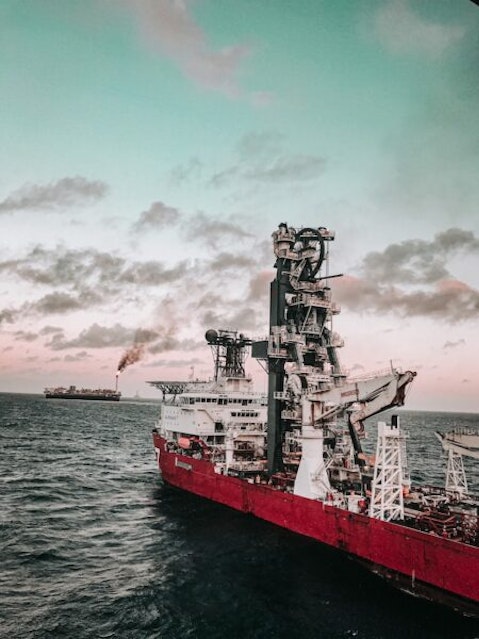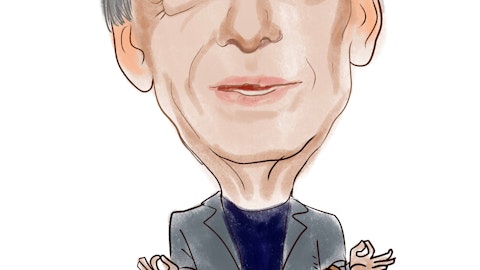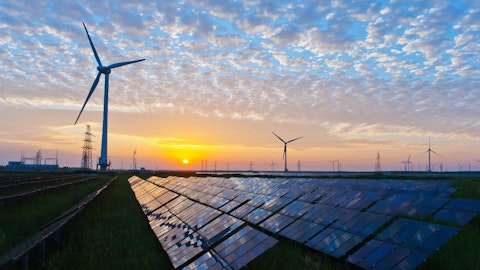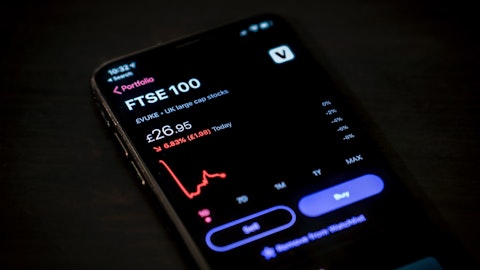Cenovus Energy Inc. (NYSE:CVE) Q4 2022 Earnings Call Transcript February 16, 2023
Operator: Good day, ladies and gentlemen, and thank you for standing by. Welcome to Cenovus Energy’s Fourth Quarter and Year-end 2020 Results. As a reminder, today’s call is being recorded. . Please be advised that this conference call may not be recorded or rebroadcast without the expressed consent of Cenovus Energy. I would now like to turn the conference call over to Ms. Sherry Wendt, Vice President, Investor Relations. Please go ahead, Ms. Wendt.
Sherry Wendt: Thank you, operator, and welcome, everyone, to Cenovus’ 2022 Year-end and Fourth Quarter Results Conference Call. Please refer to the advisories located at the end of today’s news release. These describe the forward-looking information, non-GAAP measures and oil and gas terms referred to today. They also outline the risk factors and assumptions relevant to this discussion. Additional information is available in Cenovus annual MD&A and our most recent AIF and Form 40-F. All figures are presented in Canadian dollars and before royalties unless otherwise stated. Alex Pourbaix, our President and Chief Executive Officer, will provide brief comments, and then we’ll take your questions. We ask that you please hold off on any detailed modeling questions and follow up on those directly with our Investor Relations team after the call.
And please also keep to 1 question, with a maximum of 1 follow-up. You can rejoin the queue for any other questions. Alex, please go ahead.
Alexander Pourbaix: Thanks, Sherry, and good morning, everybody. Before we talk about our fourth quarter and annual results, I thought I’d take just a minute to discuss our other news that we announced this morning. After our AGM at the end of April, I will be shifting to the role of Executive Chair. John will become our next President and CEO. This is something that I’ve been working with the Board on for quite some time, ensuring a robust plan for executive succession, including developing strong internal candidates has been a key focus of mine and the rest of the Cenovus’ Board. And I am very proud to say, in my entire career, I have never worked with this capable a leadership team as I am lucky to have here at Cenovus today.
When I joined Cenovus, the feedback we received from shareholders was that the company had a — historically, lacked a strong succession plan. One of my very early acts as President and CEO was to bring on John as CFO to help achieve 3 key priorities we’ve set for Cenovus. Optimize our cost structure, expand our market access and strengthen our balance sheet. And as many of you know, when and — when John joined the company, he and I weren’t strangers — in fact, we’ve known each other for the better part of our careers. And I knew that John’s towering strengths of discipline, accountability, work ethic and deep knowledge of the energy business would be of huge help to me as we embarked on delivering on those priorities. The entire leadership team and all the people in this company came together to deliver on those priorities, culminating with the Husky transaction and John’s move to COO.
I won’t say it’s all been a walk in the park. The reality is that we’ve worked through some incredible challenges along the way. But I can say with complete honesty that John and I have never been misaligned on what we believe is best for the company. I think it’s fair to say we come at problems from different perspectives. And I think this diversity has actually made us a really successful team. Since the Husky acquisition, we’ve achieved many milestones together. I’ll take a moment to revisit just a few. We delivered above and beyond our targeted synergies from the Husky deal. We continued to aggressively reduce debt, and we implemented and are executing on our shareholder returns framework. We’ve also evolved the asset portfolio with opportunistic A&D transactions, this to better position the company to maximize the heavy oil value chain, which will support further growth in cash flow and shareholder returns.
But I think, most importantly, we’ve been able to create a low-cost, resilient, integrated energy company that is profitable at all parts of the commodity cycle. John has been instrumental in these efforts and our vision for Cenovus. With his breadth of experience, strategic thinking and incredible commercial acumen, there is no better person to be the next President and CEO of this company. While I could have stayed on in the role for another year or 2, Cenovus is in really great shape, and I think John has earned the right to lead Cenovus. And I don’t think there could be a better time for this leadership transition. Thanks, John.
Jonathan McKenzie: Well, thanks, Alex, and maybe I’ll chime in, and thank you for those kind words. And you’re right, this company has accomplished a great deal over the past 5 years under your leadership. You’ve really built a much more resilient Cenovus and something that I’m really proud of is we have a reputation for delivering our commitments under your stewardship. In my view, you’ve left the CEO chair and the company in a much better condition than you found it, which is really a great measure of success. So I’m very much looking forward to the next phase of Cenovus and continuing on the path that you’ve set us on. As you said earlier, you and I have known each other for the better part of our careers, including working closely together on other projects prior to us getting together at Cenovus.
And through that time, we’ve been good friends. So I’m thrilled that you’re staying on as Executive Chair and continuing your ongoing support and advocacy for Cenovus, and more broadly, the Canadian energy industry. And I’m grateful to continue working closely with you over the coming years. So thank you very much.
Alexander Pourbaix: Well, thanks, John. As many of you are aware, an increasing — increasingly significant proportion of my time is being spent on external efforts, including actively partnering with governments to help support Canada in achieving its climate goals, while also remaining a competitive economy in which Canadians can thrive. And next to safety, there is nothing more important to Cenovus in our industry than reaching a durable solution between government and industry to achieve our emission aspirations. Once I move to the executive chair position, I intend to dedicate even more time to this pivotal external issue for both Cenovus and our industry. Besides my Board governance responsibilities, I will also continue to work closely with John to progress the strategic direction we’ve established for Cenovus.
I really can’t tell you guys how happy I am for John in his new role and how excited I am about my continuing role with this great company and our people. So with that, maybe I’ll turn to the year-end and quarterly results. And as I do every quarter, I’m going to start with our top priority, health and safety. I would like to recognize our well delivery group, which reduced its recordable injury frequency from 0.91 in Q1 2022, down to 0.53 over the full year. This performance improvement comes with focus and dedication and I am really proud of what this group has been able to accomplish as we continue to ramp up our drilling activity. Similarly, our recordable injury frequency at our Lima refinery fell to 0.1 from 0.5 in 2021. This is an absolutely outstanding result, and we are all proud of our team in Lima for this achievement.
That being said, some of the recent incidents at our nonoperated refineries are an important reminder to us that we must never become complacent or take our safety performance for granted. We will be unrelenting in our efforts to ensure that Cenovus’ strong safety culture is embedded at every site where we operate. This includes Toledo, where we expect to close the acquisition of the refinery at the end of this month, and at Superior as we commence start-up. Turning to our operating results, I’ll begin with the upstream. Looking back on the year, there was a lot of A&D activity that helped us streamline our upstream business. By acquiring the remaining 50% of Sunrise, we now have full control to deploy Cenovus’ operating model and take that asset from about 45,000 barrels per day today, back up to its nameplate production of 60,000 barrels a day and beyond.

Photo by Emmaus Studio on Unsplash
This is an excellent opportunity for Cenovus to show our SAGD expertise and the benefits of our operating model. We also sold the Tucker oil sands asset in the Wembley conventional asset this year for total proceeds of $950 million combined. These sales helped accelerate our deleveraging efforts through the year. It also allows us to focus our capital spend on higher return projects. Looking at the Q4 operating results, total production averaged over 806,000 BOE per day, up about 30,000 BOE per day from the third quarter. This is a significant achievement of our operating teams who did an exceptional job of managing through extreme winter weather in December. The conventional business contributed about $250 million of operating margin in the fourth quarter while keeping production rates relatively flat.
This winter, the team was focused on adding new wells, some pre-purchasing of materials that were slated for 2023, and advancing some infrastructure projects to support multiyear development in this segment. The Asia-Pac region also contributed to the quarter-over-quarter production increase. In China, we saw our partners draw gas above daily contract rates and additional production came online in Indonesia from new wells recently completed. In the Atlantic segment, production remained relatively flat. However, with the Terra Nova FPSO asset life extension now complete, we are expecting the Terra Nova field back online in the second quarter of 2023. Turning to the Downstream. I will start by highlighting some of the successes we achieved at our operated assets over the year.
The Lima refinery continues to run reliably and achieved record throughput in 2022. It generated about $1.1 billion in operating margin this year and also delivered its best ever safety performance. These results reinforce our philosophy that strong safety performance drives strong reliability, which, in turn, drives strong financial results. The Lloydminster upgrader and refinery continued to demonstrate strong utilization through the year even with turnarounds at each asset. The upgrader was able to take advantage of a wide synthetic to heavy oil diff, while the refinery continued to capture strong asphalt margins. Together, these 2 assets delivered almost $700 million in operating margin in the year. We also made significant progress on the Superior rebuild with start-up underway.
The refinery began circulating hydrocarbons in mid-February, with throughput expected to start mid-March. The refinery remains on schedule to ramp up to full operations in the second quarter of 2023. And, at Toledo, the acquisition of the remaining 50% of the refinery remains on track to close by the end of February. The repair estimate stemming from the September fire is not significant, and the refinery is expected to get up to full rates by around mid Q2 this year. Turning back to our Q4 results. As we announced in early January, our downstream operations were affected by some extremely cold weather, unplanned operational events and a third-party pipeline outage back in December. This morning, we provided a detailed update in our news release, highlighting that almost all of our downstream assets were back up and running at normal rates.
The exception is the Wood River refinery, where an incident in December reduced throughput modestly. The refinery’s utilization has steadily increased since the 1st week of January, and is currently running at a very substantial proportion of its normal throughput rates. We expect the refinery to return to normal rates during the second quarter. Turning to our Q4 operating margins. Oil prices were lower in Q4, which impacted oil sands pricing and margins. Sales volumes were less than production as we look to avoid wider differentials in December, driven by the third-party pipeline outage. This also impacted oil sands operating margin in the quarter. However, those inventory volumes should serve as a future tailwind when sold. In U.S. manufacturing, the fall in commodity prices through the quarter resulted in a negative FIFO impact of roughly $180 million in Q4.
The U.S. manufacturing operating margin includes operating costs of about $40 million to $50 million a month for Toledo and Superior. And this is really important for everyone to keep in mind given that those operating costs have been coming without any throughput to offset them. As these 2 refineries come back online and start generating revenues, the per barrel metrics of the U.S. Manufacturing segment will significantly improve. Turning to our annual financial results. I want to highlight some of the achievements we hit in 2022. I’ll start with earnings, which increased tenfold from 2021. Annual adjusted funds flow was $11 billion, which we put to good use, reducing debt by more than half and investing about $3.7 billion in the business.
That capital investment supports other businesses and directly generates jobs and economic benefits in the areas where we operate. The financial discipline and continued focusing on deleveraging also led to ratings upgrades by 2 of the credit rating agencies in the fourth quarter. We also tripled our base dividend in Q1 2022, and rolled out our shareholder returns framework. Overall, we delivered more than $3.4 billion to our shareholders this year through a combination of share buybacks and dividends. At the same time, we will contribute over $6 billion in taxes and royalties to Canada and $100 million of taxes in the U.S. Moving now to our fourth quarter financial results. Adjusted funds flow was about $2.4 billion and free funds flow was $1.1 billion.
Net debt came down another $1 billion over the quarter and landed at just over $4.3 billion as of year-end. Under our shareholder returns framework, we’ve allocated half of Q4 excess free funds flow to shareholder returns, which has been delivered in the form of share buybacks during the quarter. Looking ahead, there’s a couple of factors that will increase net debt in the first quarter. The first is a cash tax liability payment in Q1 of about $1.2 billion for taxes that were accrued over 2022. Secondly, we expect to close the Toledo refinery purchase for another USD 300 million, plus closing adjustments, including working capital at the end of this month. Now that we are cash taxable in all jurisdictions, taxes will be paid on a quarterly basis going forward.
We have become increasingly confident we might get under our net debt floor of $4 billion around the end of the fourth quarter. However, the extreme winter weather, third-party pipeline outages, and operational challenges in December were unanticipated and ultimately prevented us from getting all the way there. Net debt has been forecast to increase in Q1 2023 above the net debt floor based on the 2022 cash tax payment alone. The issues we experienced in December delayed our forecast timing of reestablishing the net debt floor in 2023 by about 2 months. Given where net debt sits today, and assuming commodity prices remain around current levels, we now expect net debt to be above the $4 billion floor until around the end of the third quarter.
While some impacts from weather and unplanned outages continued into early 2023, we remain confident in our key operating targets. Our 2023 corporate guidance remains unchanged. Turning to our plans to reduce emissions. Cenovus and its peers at Pathways Alliance, reached an important milestone in Q4. We’ve entered into an agreement with the government of Alberta that allows us to start a detailed evaluation of the proposed storage hub for our carbon capture project. This work is necessary to get us to the next stage in the regulatory process. A significant amount of work is underway with the Pathways Alliance as we progress feasibility studies, environmental assessments and early engineering work for the carbon capture and storage project and also advance other technologies.
Conversations with the provincial and federal governments about their role in partnering with us to advance these decarbonization efforts also continue to go well. Within Cenovus, we continue to advance our own emissions reduction strategy, including progress on carbon capture and storage project plans for several facilities. Cenovus is also focused on helping support economic self-sufficiency in indigenous communities. Last year, we spent the equivalent of about $1 million a day on goods and services from Indigenous owned businesses, and we are already halfway to our target of spending at least $1.2 billion with these businesses between 2019 and the end of 2025. Now I’ll do a quick recap of the year before we move to Q&A. 2022 was a really successful year for Cenovus.
We improved our safety performance across the business year-over-year. We generated adjusted funds flow 53% higher than the year before. Meanwhile, we reduced net debt by more than half, while also reducing cash — increasing cash returns to shareholders to 6.5x the prior year. That’s almost $3 billion in incremental shareholder returns year-over-year. Our balance sheet is in great shape entering 2023, and we look forward to delivering even greater returns as we grow cash flow and pursue our net debt floor. So with that, we’re happy to take questions.
See also 10 Hot Healthcare Stocks To Buy Now and Michael Burry Stock Portfolio: 10 Stocks He Sold.
Q&A Session
Follow Cenovus Energy Inc (TSE:CVE)
Follow Cenovus Energy Inc (TSE:CVE)
Operator: . We’ll go to Greg Pardy with RBC Capital Markets.
Greg Pardy: And I think first is, Alex and John, congratulations to you both. Fantastic job and great to see, Alex, that you’re going to continue to be involved on a go-forward basis. So maybe what I’ll do is I’ll pose a question that I’m getting, which has been a little surprising, but that is mainly related to just acquisitions as it relates to Cenovus. And then specifically in the upstream, and to get even more granular, it’s been suggested that you may be looking in the deep basin. But as opposed to just sort of addressing the acquisition question, I’m interested in how — what aspects of the business do you want to reshape? I’m assuming the downstream is probably predominant in that equation, but just any color would be great on that front.
Alexander Pourbaix: Sure, Greg. Happy to talk about that. I mean like — maybe I can kind of simplify this for people. And I’ll really talk about what do I view as the key priorities for the company in 2023. And right off the bat, and I’ll say this til I’m long gone, but safety is #1 for this company. And you heard me talk about the work that we’ve done and what we’ve been able to accomplish, and it is everybody’s focus on getting the new assets in the company to the same level of safety that we’ve enjoyed in this company for all these years. So on top of that, I would say, I have 2 real focuses. The first is getting to $4 billion as soon as we possibly can. And I think John made this comment in his remarks, but people, when we really pride ourselves, when we say something, we really mean it, and we intend to deliver on it.
And that $4 billion target, that is sacrosanct to us. And we’re not going to sacrifice anything to get to that target. The next priority for me beyond that is really getting this new portfolio we have in the Downstream, getting it operating, once again, at the same level of operational sort of efficiency and safety and quality as we experience in our upstream business. We’re bringing — as you heard me talk about, we’re bringing Superior back. We’re already starting to bring it back. The Toledo deal is going to close very shortly. And everybody in this company, and particularly John and Keith, are just laser-focused on bringing those assets in and showing and demonstrating to our investors that this downstream business can perform as well as we know it can.
So those are the priorities. We’re not going to sacrifice anything for those priorities. And we always look at M&A transactions. I’ve always said we’re opportunistic about that. But we will not — we would not ever do anything from that perspective. that would materially move us from that target, that $4 billion target I’ve said, that is our focus.
Operator: We’ll take our next question from Dennis Fong with CIBC World Markets.
Dennis Fong: I’d also like to reiterate what Greg said and just congratulate the 2 of you on kind of the next half of your career. My first question here is just related to your — the combination of both the balance of integration, but also more specifically the refining operations. Just given what you’ve seen more recently with respect to some of the downtime on pipelines as well as outages by various refineries, how are you guys thinking about the flexibility of your marketing assets going forward as well as were there any albeit near-term learnings from some of the downtime experienced with Q4 that you’d like to implement on the various assets going forward?





